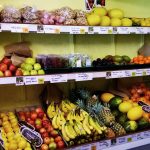Investigating health with communities
February in the UK is not exactly known for its warm weather. This particular day in February is no exception from the rule, but still a small group of local people have gathered at a community centre ready to brave the cold. The group is taking part in C3’s Healthy Communities project and they are about to embark on an investigative walk in their neighbourhood using an app* that will help them to see whether their local area helps or hinders their ability to live healthily.
Once out of the community centre, the group takes quickly to using the android tablets. Ducking in and out of shops looking for healthy foods and scouring parks to assess the litter situation, it soon becomes evident that the participants are spotting things in their area that they may have seen every day but never noticed. Looking at the foods promoted at a local supermarket someone exclaims ‘all you see is junk food – it’s like ‘oh my gosh!’ Other observations include the lack of healthy foods at the payment counter in the corner shop, how many deals there are on alcoholic drinks and how difficult it can be finding out where to book the local tennis courts. Issues that may seem small are in fact creating unnecessary barriers to healthy lifestyles!
Realising how hard it is to be healthy in your neighbourhood opens up the possibility to discuss who is responsible for creating good health – the individual or society? And how come accessing a healthy lifestyle is easier in some areas and more difficult in others? The Healthy Communities project helps participants to explore these issues and then gives them the opportunity to co-design local interventions to begin to address them.
*The CHESS™ tool is an innovative way to collect quantitative data on the built environment within a defined area. It is downloadable as an app for android tablets and lets users examine local assets, for example shops, restaurants or spaces for physical activity, such as parks or gyms. Questions are asked that give an indication as to whether the local area is conducive to good health or not. For example, are healthy food options available? Do restaurants identify healthy options on their menus? Are physical activity opportunities affordable and accessible? Collecting this data creates a narrative around the local area and helps participating community members create evidence on which to base an argument for change.

